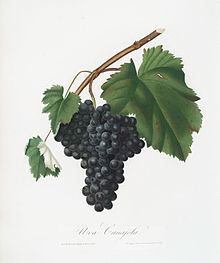Canaiolo nero
| Canaiolo Nero | |
|---|---|
| Synonyms | Calabrese, Canaiola, Canaiolo - for more see the Synonyms section |

|
|
| Art | Grape vine ( Vitis vinifera subsp. Vinifera ) |
| Berry color | blue black |
| use | |
| origin | Italy |
| known since | 1303 |
| VIVC no. | 2037 |
| List of grape varieties | |
Canaiolo Nero or just Canaiolo is an old red wine variety from Italy . Their cultivation is limited to central Italy and Sardinia .
origin
Is an old autochthonous grape variety from Italy - Tuscany region.
In some sources it is assumed that the very old variety or an ancestor was already known to the Etruscans and was therefore called Vitis vinifera etrusca . This Italian red wine variety was certainly mentioned in 1303 by the scholar Petrus de Crescentiis (1230–1321). In a work by agronomist Giovanni Soderini (1526–1596) it was praised as one of the best Tuscan varieties under the name 'Canaiuola' at the end of the 16th century. The Chianti recipe recommended by Baron Ricasoli (1809–1880) played an important role and from the 18th to the 19th century was even more important than today's main grape variety ' Sangiovese '.
Ampelographic varietal characteristics
- The shoot tip is open. It is very hairy woolly white, with a slight reddish tinge.
- The young leaves are woolly hairy and are reddish in color.
- The thick leaves are rounded, medium to strong five-lobed. The stem bay is elliptical in shape, with the ends of the stem bay overlapping. The blade is bluntly serrated. The teeth are medium in size. The leaf surface is slightly blistered.
- The cylindrical grape is sometimes shouldered, medium to large in size. The round to oval berries are medium-sized and blue-black in color.
Ripeness: late - ripens about 35 days after the Gutedel .
properties
It has poor growth and only low yields. Has a very good resistance to grape rot.
In Umbria there is also a white variant, Drupeggio (in Orvieto also known under the synonym Canaiolo Bianco ).
distribution
As part of Chianti , the variety is particularly widespread in Tuscany . It is less common in other central Italian wine-growing regions , such as Lazio, Liguria, Marche, Sardinia and Umbria . The grape variety is permitted in the DOC wines Barco Reale di Carmignano , Carmignano , Chianti , Chianti Classico , Colli dell'Etruria Centrale , Colli Etruschi Viterbesi , Colline Lucchesi , Lago di Corbara , Maremma Toscana , Montecarlo , Rosso di Montepulciano , Rosso Orviet , San Gimignano , Torgiano , Torgiano Rosso Riserva and Vino Nobile di Montepulciano .
In the 1990s, the area under vines was 4,306 hectares. In 2013, the worldwide cultivation area was only 1068 hectares. In 2010, Canaiolo Nero increased to 1,068 hectares (in 2000 it was 2,304 hectares) and for Canaiolo Rosa only 1 hectare (114 in 2000).
Wine
As a rule, the late-ripening, low-yielding variety produces extremely colorful, full-bodied and velvety red wines with a slightly bitter tone. It is used almost exclusively as a blending partner for the Sangiovese.
Synonyms
Synonyms: 50: Cacchiume Nero, Caccione Nero, Cacciuna Nera, Cagnina, Calabrese, Canaiola, Canaiolo, Canaiolo Borghese, Canaiolo Cascolo, Canaiolo Colore, Canaiolo Grosso, Canaiolo Nero A Raspo Rosso, Canaiolo Nero Comune, Canaiolo Nero Grosso, Canaiolo Nero , Canaiolo Pratese, Canaiolo Romano, Canaiolo Rosa, Canaiolo Rosso Piccolo, Canaiolo Toscano, Canaiuola, Canaiuolo, Canajolo, Canajolo Lastri, Canajolo Nero Grosso, Canajolo Piccolo, Canajuola, Canajuolo Nero Comune, Canina, Cannaiola di, Cannaiola Martchie Marta, Cannajola, Colore, Colore Canino, Merla, Tindillaro, Tindilloro, Uva Canaiolo, Uva Canajola, Uva Canajuola, Uva Canina, Uva Colore Canaiola, Uva dei Cani, Uva Donna, Uva Fosca, Uva Grossa, Uva Marchigiana, Uva Merla, Vitis Vinifera Etrusca.
See also
literature
- Hans Ambrosi , Bernd HE Hill, Erika Maul, First H. Rühl, Joachim Schmid, Fritz Schuhmann: Color Atlas of Grape Varieties. 3. Edition. Eugen Ulmer, 2011, ISBN 978-3-8001-5957-4 .
- Jancis Robinson , Julia Harding, José Vouillamoz : Wine Grapes , 1st edition 2012, Penguin Books, London, ISBN 978-0-06-220636-7 .
- Pierre Galet : Dictionnaire encyclopédique des cépages . 1st edition. Hachette Livre, 2000, ISBN 2-01-236331-8 .
- Jancis Robinson : The Oxford Wine Lexicon . 2nd Edition. Gräfe & Unzer, Munich, 2003, ISBN 3-7742-0914-6 .
Individual evidence
- ↑ Jancis Robinson , Julia Harding, José Vouillamoz : Wine Grapes , 1st edition 2012, Penguin Books, London, ISBN 978-0-06-220636-7 .
- ↑ K. Anderson, NR Aryal: Database of Regional, National and Global Winegrape Bearing Areas by Variety, 2000 and 2010, Wine Economics Research Center, University of Adelaide, December 2013 (first revision April 2014) (second revision May 2014) (third revision July 2014).
- ↑ Canaiolo nero in the database Vitis International Variety Catalog of the Institute for Vine Breeding Geilweilerhof (English), accessed on March 30, 2020

